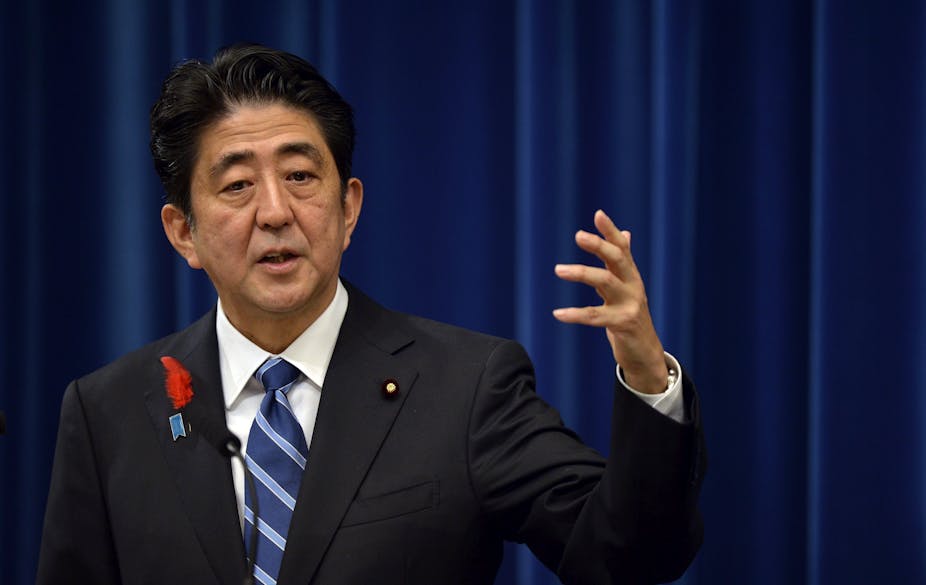Japan’s Prime Minister Shinzo Abe announced Tuesday a significant increase in the country’s consumption tax and unveiled a ¥5 trillion ($54.5 billion) stimulus package to mitigate the higher levy’s negative impacts, including a ¥10,000 cash allowance for low income earners and various tax cuts to encourage corporate investment
Abe said the tax rise – a jump from 5% to 8% next year – will be needed to ensure the social security system remains sustainable. But he promised the economy will not stray from its current track toward long-awaited recovery.
Abenomics – a set of policies Abe is championing in the hope of stimulating macroeconomic growth – is often described as having “three arrows”.
The first, beginning early 2013, has been a bold monetary policy aimed at dispelling the deflation mindset. The second “arrow” is a flexible fiscal policy aimed at igniting the economy through expansion of public investment.
Now the third arrow: a program to achieve growth through stimulating private investment.
Stimulus and tax hikes may sound contradictory to each other. But Abe believes the stimulus package will offset some of the immediate negative effects of the tax hike.
Japan’s national debt is huge. The country’s public debt-to-GDP ratio in 2012 is 214.3% (Australia’s ratio is 29.3% in the same year).
Japan’s public debt as % of GDP

An IMF report released in August concluded the consumption tax would have to be raised to at least 15% for that debt-to-GDP ratio to fall.
Implementing a consumption tax increase from 5% to 10% by 2015 is a necessary first step in this direction, the IMP report said, and in this sense, Abe’s planned tax rise goes some way to meeting that.
And while Japan’s unemployment rate is relatively low compared to other developed countries – 3.9% compared to Australia’s 5.5%, for instance – the proportion of people in work has been declining since 2000. ABS figures show the proportion of people working in Japan will fall from 64% in 2010 to 60.7% by 2015 (Australia’s will be 66.1%, slightly above world average).
Given this trend – and the declining tax base it represents – and the huge national-debt, these tax hikes are just an inevitable first step and substantial additional measures will be needed to increase government revenue.
It’s not all bad news
On Tuesday the Bank of Japan’s “tankan” report showed a sharp increase in business sentiment among manufacturers, especially large-sized enterprises.
Last month, the Cabinet Office released the data that shows an upward revision in April-June GDP to an annualized 3.8% growth from a preliminary 2.6% increase, not be a bad number considering the declining labor force.
Abe says Japan is facing a “make-or-break” moment. Failure means that the huge public debt could become a catastrophe. Broadening the personal income tax base to raise revenue and improving incentives to work – incentives for female labor participation, for example – are necessary measures to avert this.
To make personal consumption and corporate capital investment truly sustainable, the government needs to allocate the budget and policy resources efficiently to promote the expansion of private investment, and cultivate new markets.
And the yen’s appreciation, related to the first “arrow”, has brought up energy cost in Japan, which together with the increased consumption tax will hurt the business of small and medium-sized enterprises.
To stabilize the business of these enterprises, it will be necessary to take some measures for these small and middle-sized firms.
In September, Tokyo won the right to host the Olympic Games for the second time. The Tokyo Olympics 1964 was a symbol of economic growth in Japan. Some media reported that the Tokyo Olympics 2020 is Abe’s forth arrow. Japanese symbolism of “three arrows” indicates that one arrow can be easily broken but three arrows at once would not.
Abe needs more arrows and needs to implement them promptly. A ¥1000 trillion ($10.46 trillion) economy is too big to bail and Japan’s economy is too big to fail.

